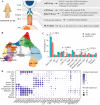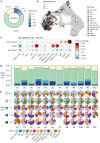Identification of potential vaccine targets for COVID-19 by combining single-cell and bulk TCR sequencing
- PMID: 34047471
- PMCID: PMC8140189
- DOI: 10.1002/ctm2.430
Identification of potential vaccine targets for COVID-19 by combining single-cell and bulk TCR sequencing
Conflict of interest statement
The authors declare no conflict of interest.
Figures




Similar articles
-
Dynamic blood single-cell immune responses in patients with COVID-19.Signal Transduct Target Ther. 2021 Mar 6;6(1):110. doi: 10.1038/s41392-021-00526-2. Signal Transduct Target Ther. 2021. PMID: 33677468 Free PMC article.
-
The characteristics of TCR CDR3 repertoire in COVID-19 patients and SARS-CoV-2 vaccine recipients.Virulence. 2024 Dec;15(1):2421987. doi: 10.1080/21505594.2024.2421987. Epub 2024 Nov 4. Virulence. 2024. PMID: 39468707 Free PMC article. Review.
-
COVID vaccine makers brace for a variant worse than Delta.Nature. 2021 Oct;598(7882):552-553. doi: 10.1038/d41586-021-02854-3. Nature. 2021. PMID: 34671153 No abstract available.
-
Bonne réaction des personnes âgées au vaccin anti-Covid mRNA-1273 (Moderna).Rev Med Suisse. 2020 Oct 7;16(709):1895. Rev Med Suisse. 2020. PMID: 33026736 French. No abstract available.
-
T Cell Memory: Understanding COVID-19.Immunity. 2021 Jan 12;54(1):14-18. doi: 10.1016/j.immuni.2020.12.009. Epub 2020 Dec 19. Immunity. 2021. PMID: 33406391 Free PMC article. Review.
Cited by
-
The Application of Single-Cell Technologies for Vaccine Development Against Viral Infections.Vaccines (Basel). 2025 Jun 26;13(7):687. doi: 10.3390/vaccines13070687. Vaccines (Basel). 2025. PMID: 40733664 Free PMC article. Review.
-
A novel biomarker of COVI-19: MMP8 emerged by integrated bulk RNAseq and single-cell sequencing.Sci Rep. 2024 Dec 28;14(1):31086. doi: 10.1038/s41598-024-82227-8. Sci Rep. 2024. PMID: 39730651 Free PMC article.
-
MutCov: A pipeline for evaluating the effect of mutations in spike protein on infectivity and antigenicity of SARS-CoV-2.Comput Biol Med. 2022 Jun;145:105509. doi: 10.1016/j.compbiomed.2022.105509. Epub 2022 Apr 9. Comput Biol Med. 2022. PMID: 35421792 Free PMC article.
-
Single-cell profiling of T and B cell repertoires following SARS-CoV-2 mRNA vaccine.JCI Insight. 2021 Dec 22;6(24):e153201. doi: 10.1172/jci.insight.153201. JCI Insight. 2021. PMID: 34935643 Free PMC article.
-
Impact of mutations in SARS-COV-2 spike on viral infectivity and antigenicity.Brief Bioinform. 2022 Jan 17;23(1):bbab375. doi: 10.1093/bib/bbab375. Brief Bioinform. 2022. PMID: 34518867 Free PMC article.
References
Publication types
MeSH terms
Substances
Grants and funding
LinkOut - more resources
Full Text Sources
Other Literature Sources
Medical
